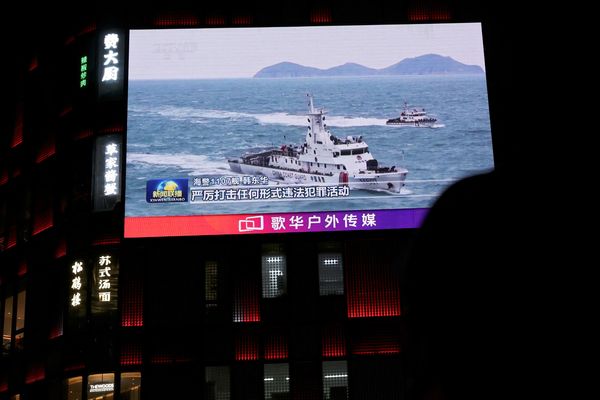
A Canadian aircraft involved in the search for the deep-sea vessel that went missing during a voyage to the wreck of the Titanic has detected “underwater noises in the search area”, the United States Coast Guard said.
As a result of the noises detected by the P-3 maritime surveillance aircraft, remotely operated vehicles (ROVs) were relocated “in an attempt to explore the origin of the noises”, the coastguard said on Wednesday.
So far, remotely operated underwater vehicles have “yielded negative results” but they are continuing to search, the coastguard said in a tweet.
“Additionally, the data from the P-3 aircraft has been shared with our US Navy experts for further analysis which will be considered in future search plans,” it added.
The coastguard did not detail the nature or extent of the sounds that were detected or how they were encountered.
Rolling Stone magazine, citing internal US government communications, was the first to report news of what was described as “banging sounds in the area every 30 minutes”.
“Four hours later additional sonar was deployed and banging was still heard,” the magazine said, citing an internal email sent to US Department of Homeland Security officials.
Canadian P-3 aircraft detected underwater noises in the search area. As a result, ROV operations were relocated in an attempt to explore the origin of the noises. Those ROV searches have yielded negative results but continue. 1/2
— USCGNortheast (@USCGNortheast) June 21, 2023
The missing submersible Titan, operated by US-based OceanGate Expeditions, was built to stay underwater for 96 hours, according to its specifications – giving the five people on board until Thursday morning before air runs out, according to officials.
The wreck of the Titanic, which sank on its maiden voyage in April 1912, lies about 1,450km (900 miles) east of Cape Cod, Massachusetts, and 644km (400 miles) south of St John’s, Newfoundland.
Three C-17 transport planes from the US military have been used to move commercial submersible and support equipment from Buffalo, New York, to St John’s, Newfoundland, to aid in the search, a spokesperson for US Air Mobility Command said.
The Canadian military said it has provided a patrol aircraft and two surface ships, including one with specialists in dive medicine. It also dropped sonobuoys to listen for any sounds from the Titan.
One pilot and four passengers were inside the miniature submersible early on Sunday when it began its dive to the ocean floor to view the Titanic but lost communication with a parent ship on the surface about an hour and 45 minutes into its dive.
Those on board Titan for the expedition that costs $250,000 per person are believed to be United Kingdom billionaire Hamish Harding, 58, Pakistani-born businessman Shahzada Dawood, 48, with his 19-year-old son Suleman, who are British citizens, French explorer Paul-Henri Nargeolet, 77, and American Stockton Rush, founder and CEO of OceanGate Expeditions, Authorities have not confirmed the identity of any passenger.
‘Subject passengers to potential extreme danger’
As the frantic search continued on Wednesday, news emerged that the former director of marine operations for OceanGate had raised safety concerns about the Titan before being fired from his position, according to a 2018 lawsuit.
David Lochridge’s misgivings about the safety of the missing submersible are contained in a response he filed to a lawsuit brought against him by OceanGate.
Lochridge wrote an engineering report in 2018 that said the craft under development needed more testing and that passengers might be endangered when it reached “extreme depths”, according to a lawsuit filed that year in US District Court in Seattle. OceanGate sued Lochridge, accusing him of breaching a non-disclosure agreement, and he filed a counterclaim alleging that he was wrongfully fired for raising questions about testing and safety.
The case was settled on undisclosed terms several months after it was filed.
Lochridge’s concerns primarily focused on the company’s decision to rely on sensitive acoustic monitoring – cracking or popping sounds made by the Titan’s hull under pressure – to detect flaws, rather than a scan of the hull. He said the company told him no equipment existed that could perform such a test on the 5-inch-thick (12.7-centimeter-thick) carbon-fibre hull.
“This was problematic because this type of acoustic analysis would only show when a component is about to fail – often milliseconds before an implosion – and would not detect any existing flaws prior to putting pressure onto the hull,” Lochridge’s counterclaim said.
Further, the craft was designed to reach depths of 4km (2.5 miles), where the Titanic rested. But, according to Lochridge, the passenger viewport was only certified for depths of up to 1.3km (0.81 miles), and OceanGate would not pay for the manufacturer to build a viewport certified for 4km.
OceanGate’s choices would “subject passengers to potential extreme danger in an experimental submersible”, the counterclaim said. However, the company said in its complaint that Lochridge “is not an engineer and was not hired or asked to perform engineering services on the Titan”.
He was fired after refusing to accept assurances from OceanGate’s lead engineer that the acoustic monitoring and testing protocol was, in fact, better suited to detect any flaws than a scan would be, the complaint said.







